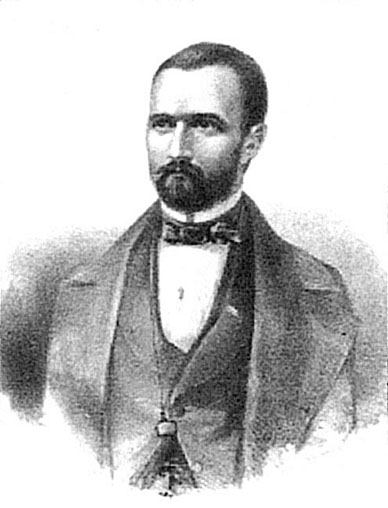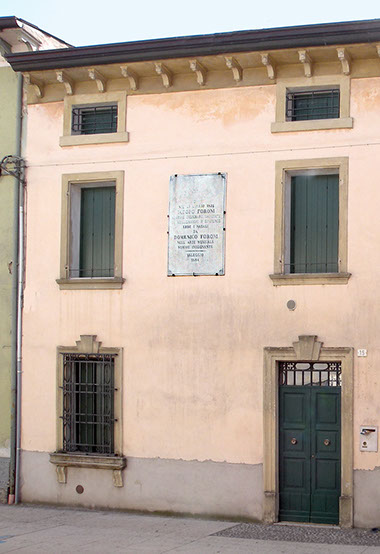Progetto di valorizzazione
del territorio di Valeggio sul Mincio
Casa Natale
dei musicisti Foroni
XVIII SECOLO
Questa dimora ha dato i natali a dei musicisti valeggiani che hanno calcato le scene dei maggiori teatri nazionali, europei e sudamericani nel corso del XIX secolo.
Il capostipite fu Domenico Foroni che nacque in Valeggio nel 1796.
Nel 1818, Domenico divenne direttore dell’accademia degli Anfioni Filocorei e maestro concertatore del Teatro Filarmonico in Verona.
A lui si deve il rinnovamento dell’ambiente musicale veronese.
Compositore egregio di musica sacra, scrisse anche brani musicali per la sinagoga di Verona.
Nel 1848, fu attivo come patriota partecipando alla prima guerra d’indipendenza.
Domenico si spense nel 1853 in Verona. Il figlio Jacopo Foroni (1824-1858), pianista e compositore insigne, fu anch’esso patriota e prese parte all’insurrezione delle Cinque Giornate di Milano nel 1848.
Stabilitosi in Svezia raggiunse grande popolarità e divenne maestro della Cappella reale di Stoccolma.
L’8 Settembre 1858, Jacopo morì prematuramente a soli 34 anni. Fra le sue opere ricordiamo i melodrammi Margherita (1848), Cristina Regina di Svezia (1850), I Gladiatori (1851) e l’opera buffa L’Avvocato Pathelin (1858).
La sua Sinfonia in do minore fu fra le musiche preferite dal grande direttore d’orchestra Arturo Toscanini (1867-1957), che la diresse e la incise su disco a New York, negli anni Quaranta del XX secolo.
Il soprano Antonietta Foroni (1822-1892), crebbe alla scuola musicale del padre Domenico e iniziò la sua attività artistica in Verona; sposò il tenore Domenico Conti e con lui ebbe una lunga e onorata carriera di cantante lirica fino alla morte avvenuta in Milano nel 1892.
La sua unica figlia, Amelia Conti Foroni (1850-1927), dotata di una notevole voce da soprano drammatico, ebbe anch’essa successo e cantò con i più famosi interpreti del melodramma italiano del tempo.
A 27 anni si unì in matrimonio con il tenore spagnolo José Maria Villena y Camero e con lui intraprese una lunga e fortunata tournée artistica in Spagna e in Sudamerica.
Rimasta vedova e ritiratasi dalle scene, si dedicò all’insegnamento nella città di Verona dove si spense nel 1927.
The Foroni Musicians Birthplace
18th CENTURY
This dwelling was the birthplace of Valeggio musicians who trod the scenes of the major national, European and south American theaters during the 19th century.
The forefather was Domenico Foroni who was born in Valeggio on 1796.
On November 1818 he married Teresa Zovetti. From the marriage five children were born, two of which became famous.
In 1818, Domenico accepted the positions of director of the Veronese academy of the Anfioni Filocorei (music lovers) and concert master of the Teatro Filarmonico; at the same time he also carried out an intense teaching activity, profoundly renewing the Veronese musical environment.
Excellent composer of sacred music, he also wrote musical pieces for the synagogue of Verona.
In 1848, he actively participated in the first war of independence.
After an intense and prolific career, Domenico died in 1853 in Verona.
His son Jacopo (1824-1858), a distinguished pianist and composer, was also a patriot and took part in the uprising of the Five Days of Milan in 1848.
Settling in Sweden, he achieved great popularity and became an appreciated conductor and master of the Royal Chapel.
On September 8th, 1858, Jacopo died prematurely at only 34 years, leaving an unbridgeable gap in those who loved him and in the world of music.
His works include the melodramas Margherita (1848), Cristina Regina di Svezia (1850), I Gladiatori (1851) and the comic opera Lawyer Pathelin (1858), as well as the Symphony in C minor which confirmed him as one of the most promising musicians of the time.
This last work was among the favorite music of the great conductor Arturo Toscanini, who directed and recorded in New York in the forties of the last century.
The soprano Antonietta Foroni (1822-1892), grew up at the musical school of her father Domenico, began her artistic activity in Verona, married the tenor Domenico Conti and with him had a long and honored career as an opera singer until her death in Milan in 1892.
Her only daughter, Amelia Conti Foroni (1850-1927), endowed with a remarkable dramatic soprano voice.
When she was 27, she marriage the Spanish tenor José Maria Villena y Camero (1844-1894), and with him, she embarked on a long and successful artistic tour in Spain and South America.
Widowed and retired from the scene, she devoted herself to teaching in the city of Verona, where she passed away in 1927.
Geburtshaus
der Musiker Foroni
18. Jhr.
Architektonische Route
In diesem Gebäude wurden die Valeggianer Musiker geboren, die im Laufe des 19. Jahrhunderts auf den Bühnen der berühmtesten nationalen, europäischen und südamerikanischen Theater auftraten.
Der Stammvater war Domenico Foroni, der 1796 in Valeggio geboren wurde. Im Jahr 1818 wurde Domenico Direktor der Akademie der Anfioni Filocorei und Konzertmeister des Philharmonikertheaters von Verona. Ihm verdanken wir die Erneuerung der Veroneser Musikwelt.
Der bemerkenswerte Kompositeur von Sakralmusik schrieb auch Musiktexte für die Synagoge von Verona. Im Jahr 1848 nahm er als Patriot aktiv am ersten Unabhängigkeitskrieg teil. Domenico starb 1853 in Verona. Sein Sohn Jacopo Foroni (1824-1858), Pianist und Komponist, war ebenfalls Patriot und nahm 1848 am Aufstand der fünf Tage von Mailand teil.
Er ließ sich in Schweden nieder, wo er sehr erfolgreich war und zum königlichen Kapellmeister von Stockholm ernannt wurde. Am 8. September 1858 verstarb Jacopo vorzeitig im Alter von nur 34 Jahren. Von seinen Werken erinnern wir an die Melodramen Margherita (1848), Cristina Regina di Svezia (1850), Die Gladiatoren (1851) und die komische Oper Advokaten Pathelin (1858).
Seine Symphonie in C-Moll gehörte zu den Lieblingsstücken des großen Orchesterdirektors Arturo Toscanini (1867-1957), der sie in New York in den 40iger Jahren des 20. Jahrhunderts unter seiner Leitung auf Platten aufnehmen ließ.
Der Sopran Antonietta Foroni (1822-1892) wuchs in der Musikschule ihres Vaters Domenico auf und begann ihre künstlerische Tätigkeit in Verona. Sie heiratete den Tenor Domenico Conti und hatte mit ihm eine lange und erfolgreiche Karriere als Opernsängerin bis zu ihrem Tod in Mailand im Jahr 1892. Ihre einzige Tochter Amelia Conti Foroni (1850-1927) verfügte über eine bemerkenswerte Stimme als dramatischer Sopran.
Sie hatte ebenfalls Erfolg und sang mit den berühmtesten Interpreten des italienischen Melodrams der damaligen Zeit. Im Alter von 27 Jahren heiratete sie den spanischen Tenor José Maria Villena y Camero. Mit ihm unternahm sie eine lange und erfolgreiche Tournee durch Spanien und Südamerika.
Als sie Witwe wurde, zog sie sich von der Szene zurück und widmete sich dem Lehrberuf in der Stadt Verona, wo sie 1927 verstarb.

Jacopo Foroni

Via Jacopo Foroni

Via Jacopo Foroni 1895
© 2019
Comune di Valeggio sul Mincio (VR)
Associazione Percorsi


